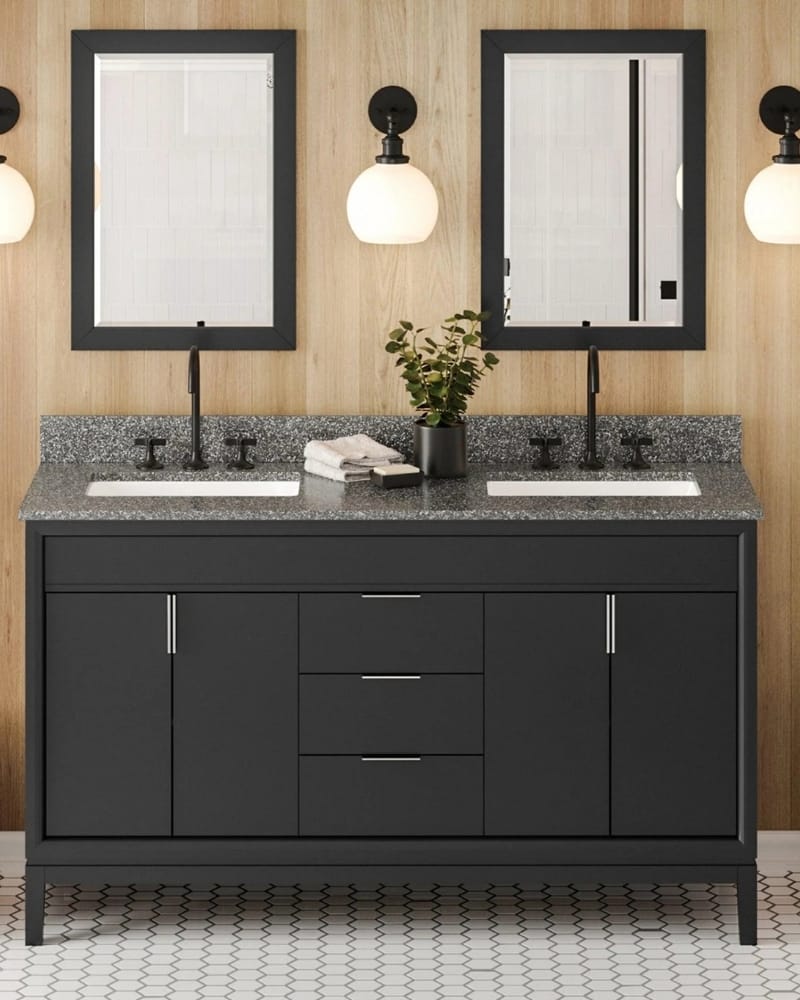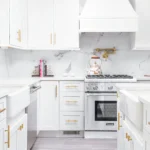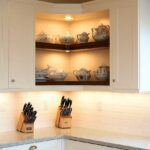Creating the perfect kitchen cabinets and countertop combination is both an art and a science that can make or break your kitchen’s overall design impact. As professional designers and contractors know, the relationship between these two dominant elements sets the foundation for your entire kitchen aesthetic while significantly influencing your home’s value. Whether you’re working with clients on high-end custom installations or helping homeowners navigate budget-friendly renovations, mastering the principles of matching cabinets and countertops is essential for creating spaces that feel cohesive, sophisticated, and timelessly appealing.
The challenge lies not just in selecting beautiful individual materials, but in understanding how different textures, colors, and finishes interact to create harmonious or jarring visual experiences. Professional designers rely on proven strategies and time-tested principles to guide their selections, ensuring that cabinet and countertop color combinations enhance rather than compete with each other. This comprehensive guide reveals the insider secrets that design professionals use to create stunning kitchen combinations that satisfy both aesthetic and practical requirements.
Understanding Color Theory in Kitchen Cabinet Design
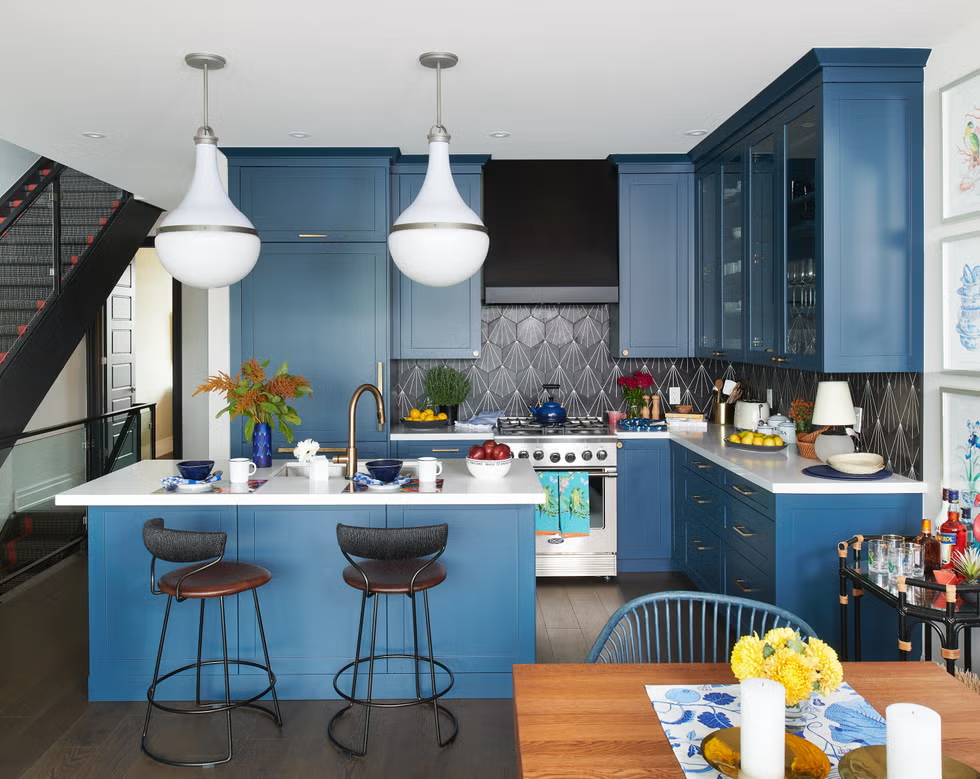
The Foundation of Successful Color Coordination
Kitchen color coordination guide principles begin with understanding how colors interact within the confined space of a kitchen environment. Unlike other rooms where natural light and space can soften color relationships, kitchens demand more careful consideration due to their functional nature and the prominence of cabinet and countertop surfaces. Professional designers rely on the 60-30-10 rule as a starting point: 60% dominant color (typically cabinets), 30% secondary color (countertops and backsplash), and 10% accent colors (hardware and accessories).
The key to successful cabinet and countertop pairing tips lies in understanding undertones rather than just surface colors. A white cabinet that appears neutral may have warm yellow undertones, cool blue undertones, or pure neutral undertones, each requiring different countertop partners to achieve harmony. Similarly, granite and quartz countertops contain complex color variations that must be considered when selecting complementary cabinet colors.
Essential Color Relationship Principles:
- Complementary Colors: Opposite colors on the color wheel create dynamic contrast
- Analogous Colors: Adjacent colors create harmonious, soothing combinations
- Monochromatic Schemes: Various shades of the same color create sophisticated depth
- Triadic Combinations: Three evenly spaced colors create vibrant yet balanced schemes
Warm vs. Cool Undertones in Material Selection
Understanding the temperature of your materials is crucial for creating harmonious kitchen design ideas that feel intentional rather than accidental. Warm undertones include reds, oranges, and yellows, while cool undertones encompass blues, greens, and purples. The most successful kitchen designs either embrace one temperature family throughout or create intentional contrast through strategic mixing.
Warm Undertone Combinations:
- Cream cabinets with golden granite featuring amber and rust veining
- Honey oak cabinets paired with warm beige quartz countertops
- Sage green cabinets complemented by cream-colored natural stone
- Rich walnut cabinets with warm gray quartz featuring gold flecking
Cool Undertone Combinations:
- Pure white cabinets with cool gray granite featuring silver and black veining
- Gray-blue cabinets paired with white quartz containing subtle gray veining
- Charcoal cabinets complemented by cool white marble with gray veining
- Navy blue cabinets with crisp white quartz featuring minimal veining
Creating Depth Through Value Contrast
Best cabinet and countertop combos often succeed because they create appropriate value contrast—the difference between light and dark elements. High contrast combinations create drama and visual interest, while low contrast combinations create serene, sophisticated atmospheres. The key is matching the contrast level to your design goals and the room’s natural lighting conditions.
High Contrast Strategies:
- Dark cabinets with light countertops create striking focal points
- Pure white cabinets with deep black granite make bold statements
- Rich espresso cabinets paired with pristine white quartz create classic elegance
- Navy blue cabinets with light gray quartz provide sophisticated contrast
Low Contrast Approaches:
- Similar-toned materials create seamless, flowing appearances
- Cream cabinets with warm beige countertops create soothing environments
- Light gray cabinets with slightly darker gray quartz maintain subtle sophistication
- Natural wood cabinets with warm stone countertops create organic harmony
Classic Kitchen Cabinet and Countertop Combinations
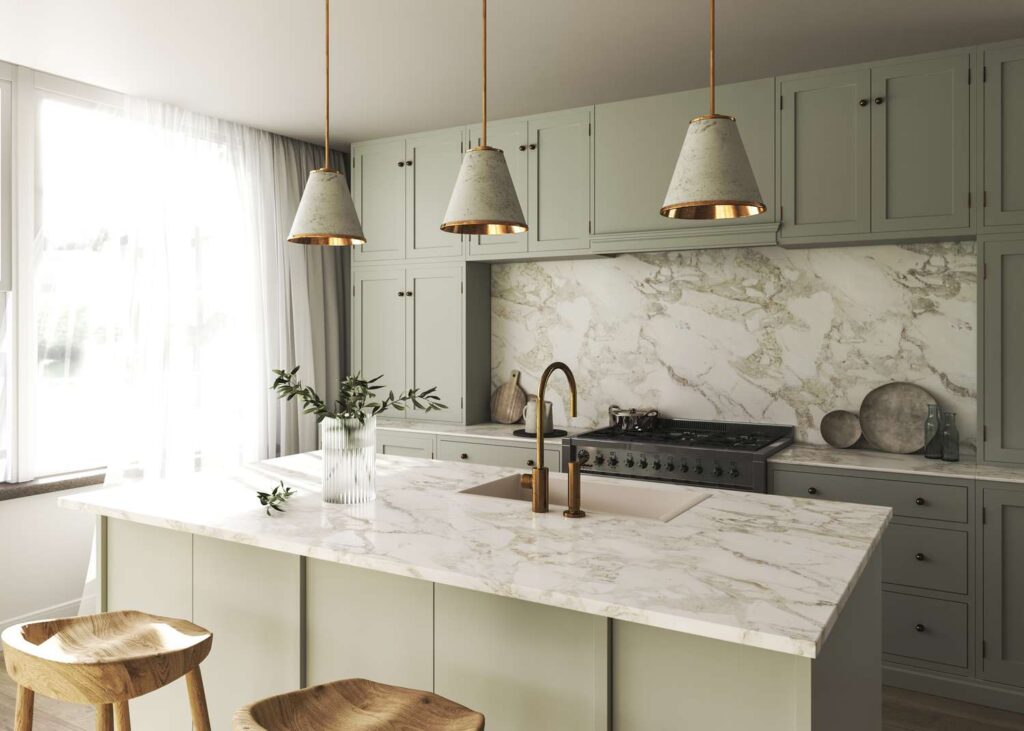
White Cabinets with Granite Countertops: Timeless Elegance
White cabinets with granite countertops remain one of the most popular and enduring combinations in kitchen design, offering versatility that works across multiple design styles while providing excellent resale value. The success of this pairing lies in granite’s natural ability to bridge multiple colors and textures, allowing white cabinets to serve as a neutral backdrop for the stone’s inherent beauty and complexity.
Premium White Cabinet and Granite Pairings:
- Shaker white cabinets with Bianco Romano granite: Creates clean, transitional appeal
- Traditional raised-panel white cabinets with Giallo Ornamental granite: Offers warm, inviting character
- Modern flat-panel white cabinets with Super White granite: Provides contemporary sophistication
- Inset white cabinets with Calacatta Gold granite: Delivers luxury hotel-inspired elegance
The key to maximizing this combination’s impact lies in selecting granite patterns that complement rather than overwhelm the cabinet style. Busy granite patterns work best with simple cabinet door styles, while subtle granite patterns can support more detailed cabinet designs without visual competition.
Granite Selection Guidelines for White Cabinets:
- Light-colored granites with subtle veining create serene, spa-like atmospheres
- Medium-contrast granites with gold and brown tones add warmth and richness
- High-contrast granites with dramatic veining create statement focal points
- Consistent pattern granites work well in large kitchen installations
Dark Cabinets with Light Countertops: Sophisticated Contrast
Dark cabinets with light countertops create some of the most sophisticated and dramatic kitchen designs, offering professional-grade aesthetics that work particularly well in larger kitchens with ample natural light. This high-contrast approach requires careful attention to balance and proportion to avoid creating spaces that feel heavy or overwhelming.
Successful Dark Cabinet and Light Countertop Combinations:
- Espresso cabinets with Carrara marble: Creates classic, timeless elegance
- Navy blue cabinets with white quartz: Offers contemporary sophistication
- Charcoal gray cabinets with light gray granite: Provides modern, monochromatic appeal
- Rich walnut cabinets with cream-colored limestone: Delivers warm, organic character
The success of dark cabinet installations depends heavily on adequate lighting design and strategic use of reflective surfaces. Under-cabinet lighting becomes essential for both task illumination and visual lightening of the overall composition. Additionally, incorporating light-colored backsplashes and strategic mirror or glass elements helps prevent the space from feeling closed-in.
Design Considerations for Dark Cabinet Installations:
- Increase lighting by 25-30% compared to light cabinet installations
- Use light-colored backsplashes to create visual breathing room
- Incorporate glass cabinet doors to add visual lightness
- Select countertops with subtle patterns to avoid overwhelming the space
Wood Tone Cabinet and Stone Countertop Harmony
Wood tone cabinet and stone countertop match combinations require understanding the inherent warmth and character of natural materials. Success depends on selecting stone countertops that complement rather than compete with the wood’s natural grain patterns and color variations. The goal is creating organic harmony that feels authentic and unforced.
Natural Material Pairing Strategies:
- Honey oak cabinets with warm beige travertine: Creates cohesive, earthy appeal
- Cherry cabinets with cream-colored granite: Offers rich, traditional elegance
- Maple cabinets with light gray quartz: Provides contemporary warmth
- Walnut cabinets with white marble: Creates sophisticated contrast with natural elements
The key to successful wood and stone combinations lies in identifying the dominant undertones in both materials and ensuring they work harmoniously together. Warm wood tones generally pair best with warm stone colors, while cooler wood stains can accommodate both warm and cool stone selections depending on the desired aesthetic outcome.
Modern Pairing Strategies for Contemporary Kitchens
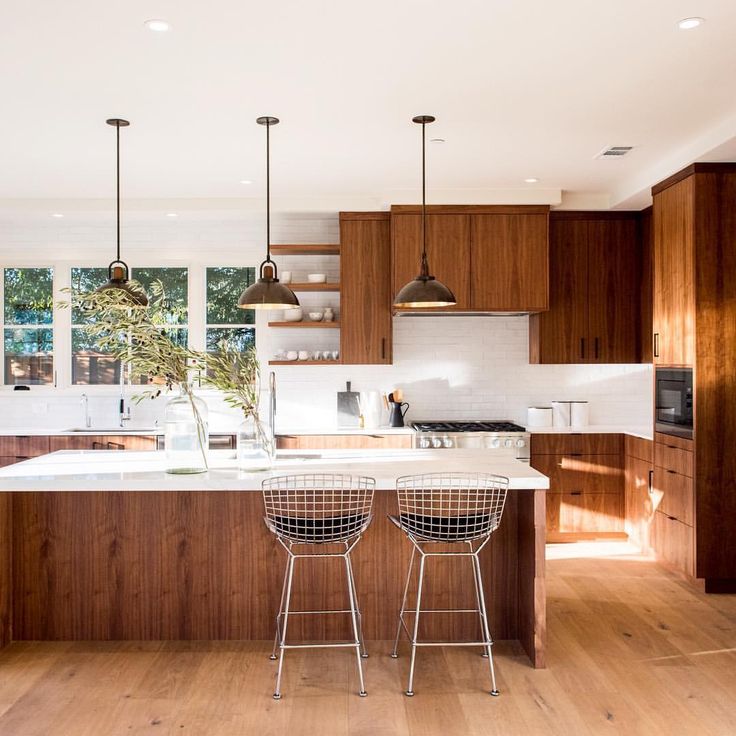
Quartz Countertops with Modern Cabinets
Quartz countertops with modern cabinets represent the cutting edge of contemporary kitchen design, offering consistent patterns, superior durability, and maintenance-free surfaces that align perfectly with modern lifestyle demands. Unlike natural stone, quartz provides predictable patterns and colors that allow for precise design coordination while eliminating the variability that can complicate material matching.
Contemporary Quartz and Cabinet Combinations:
- Flat-panel white cabinets with pure white quartz: Creates seamless, minimalist aesthetics
- Handle-less gray cabinets with concrete-look quartz: Offers industrial sophistication
- Two-tone cabinets with coordinating quartz patterns: Provides visual interest without chaos
- High-gloss cabinets with matte quartz countertops: Creates textural contrast and depth
Modern kitchen designs often emphasize clean lines, minimal ornamentation, and seamless integration of materials. Quartz countertops excel in these applications because they can be fabricated with minimal seams, integrated sinks, and consistent edge profiles that maintain the clean aesthetic that contemporary designs demand.
Advantages of Quartz in Modern Designs:
- Consistent patterns eliminate natural stone variability concerns
- Non-porous surfaces require no sealing or special maintenance
- Available in colors and patterns impossible to achieve in natural stone
- Can be fabricated with integrated sinks and custom edge profiles
Neutral Kitchen Color Palettes for Timeless Appeal
Neutral kitchen color palettes provide the foundation for sophisticated designs that remain appealing across changing trends and personal preferences. These combinations work particularly well for homeowners planning to sell within 5-10 years, as they offer broad market appeal while providing flexibility for personalization through accessories and decorative elements.
Sophisticated Neutral Combinations:
- Warm gray cabinets with cream quartz featuring subtle veining
- Greige cabinets paired with white granite containing gray and beige tones
- Soft white cabinets with light gray marble featuring minimal veining
- Taupe cabinets complemented by warm beige limestone with consistent patterns
The success of neutral palettes depends on creating subtle variations in tone and texture rather than relying on color contrast for visual interest. This approach requires careful attention to material selection, ensuring that different neutrals work harmoniously together while providing enough variation to prevent monotony.
Neutral Palette Success Strategies:
- Vary textures rather than colors for visual interest
- Incorporate natural materials to add warmth and character
- Use lighting to enhance subtle color variations
- Add personality through hardware and accessory selections
Mixing Textures in Kitchen Design
Mixing textures in kitchen design adds sophistication and visual interest without relying on bold color contrasts that may become dated or overwhelming. This approach works particularly well in contemporary and transitional kitchens where subtle sophistication is preferred over dramatic statements.
Effective Texture Combinations:
- Smooth, glossy cabinets with honed, matte countertops
- Wood grain cabinets with polished stone countertops
- Painted cabinets with leathered granite surfaces
- Metal accent cabinets with natural stone countertops
Textural contrast creates tactile interest while maintaining color harmony, allowing for sophisticated designs that feel rich and layered without being busy or overwhelming. This approach works particularly well in open floor plans where the kitchen needs to coordinate with adjacent living spaces.
Working with Different Cabinet Styles
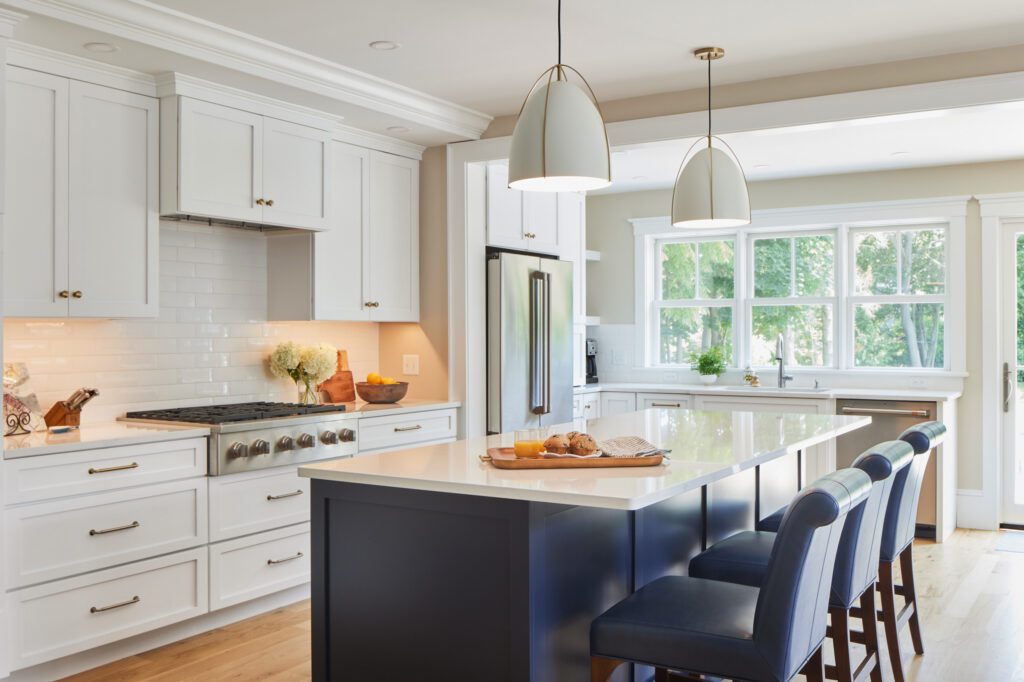
Traditional Cabinet Styles and Appropriate Countertop Partners
Traditional cabinet styles, characterized by raised panels, decorative moldings, and classic proportions, require countertop selections that complement rather than compete with their inherent detail and craftsmanship. Cohesive kitchen material selection for traditional designs focuses on materials that enhance the classic aesthetic while providing modern functionality.
Traditional Style Pairing Guidelines:
- Raised-panel cabinets work best with natural stone countertops that echo classical materials
- Glazed cabinet finishes pair beautifully with granite featuring complementary color tones
- Inset cabinet doors create premium foundations for marble and high-end granite selections
- Traditional hardware styles should coordinate with countertop edge profiles and finishes
Traditional designs often incorporate multiple materials and finishes, requiring careful coordination to maintain cohesive aesthetics. The key lies in selecting countertops that provide appropriate visual weight and character to balance the cabinet details without creating competition for attention.
Successful Traditional Combinations:
- Cream glazed cabinets with Giallo Ornamental granite
- Cherry cabinets with Uba Tuba granite featuring gold highlights
- Antique white cabinets with Calacatta marble for luxury appeal
- Sage green cabinets with cream-colored limestone for country elegance
Contemporary Cabinet Designs and Modern Countertop Options
Contemporary cabinet designs emphasize clean lines, minimal ornamentation, and seamless integration with modern appliances and technology. These designs require countertop selections that maintain the sleek aesthetic while providing practical functionality for modern cooking and entertaining needs.
Contemporary Design Principles:
- Flat-panel cabinet doors create foundations for bold countertop statements
- Handle-less designs require countertops with clean, uninterrupted lines
- High-gloss finishes pair well with both matte and polished countertop surfaces
- Integrated appliances demand countertops that accommodate seamless installation
Contemporary kitchens often feature dramatic material contrasts or sophisticated monochromatic schemes that create visual interest through texture and proportion rather than ornate details. This approach requires precise material coordination and expert installation to achieve the seamless appearance that contemporary designs demand.
Modern Combination Strategies:
- White lacquer cabinets with black granite for dramatic contrast
- Gray cabinets with white quartz featuring minimal veining
- Two-tone cabinets with coordinating quartz patterns
- Natural wood cabinets with concrete-look quartz for organic modernism
Transitional Styles That Bridge Traditional and Modern
Transitional kitchen designs combine the warmth and character of traditional styles with the clean lines and functionality of contemporary designs. This approach requires cabinet and countertop color combinations that work across style boundaries while maintaining cohesive aesthetics that feel intentional rather than indecisive.
Transitional Design Characteristics:
- Shaker-style cabinets provide versatile foundations for various countertop materials
- Neutral color palettes allow for both traditional and contemporary countertop selections
- Mixed cabinet heights create visual interest while maintaining clean lines
- Quality hardware bridges traditional and contemporary aesthetics
Transitional designs offer flexibility in material selection while requiring careful attention to proportion and balance. The goal is creating spaces that feel current and fresh while maintaining the timeless appeal that ensures long-term satisfaction and resale value.
Countertop Material Considerations
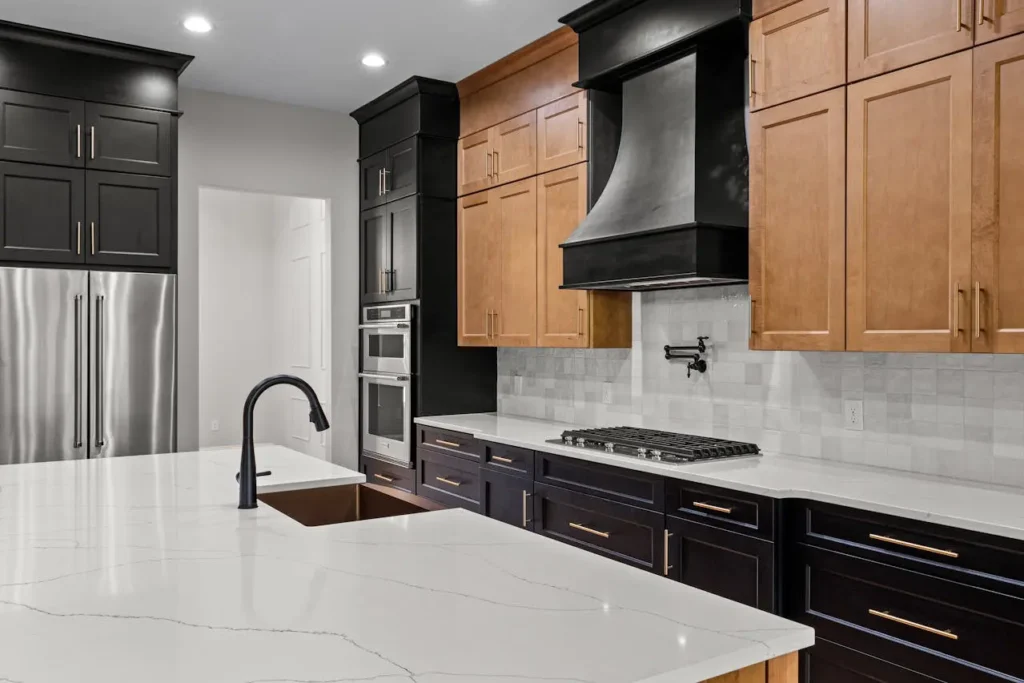
Natural Stone Options and Cabinet Compatibility
Natural stone countertops offer unique beauty and character that manufactured materials cannot replicate, but they also present specific challenges in matching cabinets and countertops due to their inherent variability and specific maintenance requirements. Understanding the characteristics of different stone types is essential for creating successful combinations.
Granite Characteristics and Cabinet Pairings:
- Light granites with subtle patterns work well with detailed cabinet styles
- Dramatic granites with bold veining require simple cabinet designs for balance
- Warm-toned granites complement wood cabinets and traditional styles
- Cool-toned granites work best with painted cabinets and contemporary designs
Marble Considerations:
- Classic white marbles provide timeless elegance with any cabinet color
- Colored marbles require careful coordination with cabinet undertones
- Heavily veined marbles work best with simple cabinet door styles
- Honed marble finishes create sophisticated, matte appearances
Quartzite and Other Natural Stones:
- Quartzite offers granite-like durability with unique patterns and colors
- Soapstone provides consistent colors that work well with traditional cabinets
- Limestone creates warm, organic appeal perfect for farmhouse and traditional styles
Engineered Materials for Consistent Results
Engineered countertop materials offer predictable patterns, consistent colors, and superior performance characteristics that make them ideal for projects requiring precise material coordination. These materials eliminate the variability of natural stone while offering design flexibility impossible to achieve with natural materials.
Quartz Advantages in Design Coordination:
- Consistent patterns eliminate concerns about slab variation
- Custom colors allow for precise cabinet coordination
- Integrated sinks create seamless, contemporary appearances
- Minimal maintenance appeals to busy modern lifestyles
Solid Surface Options:
- Unlimited color options allow for perfect cabinet coordination
- Seamless installation creates clean, contemporary appearances
- Repairable surfaces maintain appearance over time
- Integrated backsplashes create cohesive design statements
Specialty Materials for Unique Design Statements
Specialty countertop materials offer opportunities to create distinctive design statements that set kitchens apart from standard installations. These materials require careful consideration of cabinet selections to ensure successful integration while maximizing their unique aesthetic impact.
Concrete Countertops:
- Custom colors and textures allow for precise design coordination
- Integrated sinks and features create seamless, artistic appearances
- Industrial aesthetics work well with modern and contemporary cabinet styles
- Artisanal character complements rustic and farmhouse designs
Metal Countertops:
- Stainless steel surfaces coordinate with professional-grade appliances
- Copper and brass options add warmth and character to traditional designs
- Zinc surfaces provide unique patina that develops over time
- Industrial appeal works well with contemporary and loft-style designs
Creating Visual Balance and Contrast
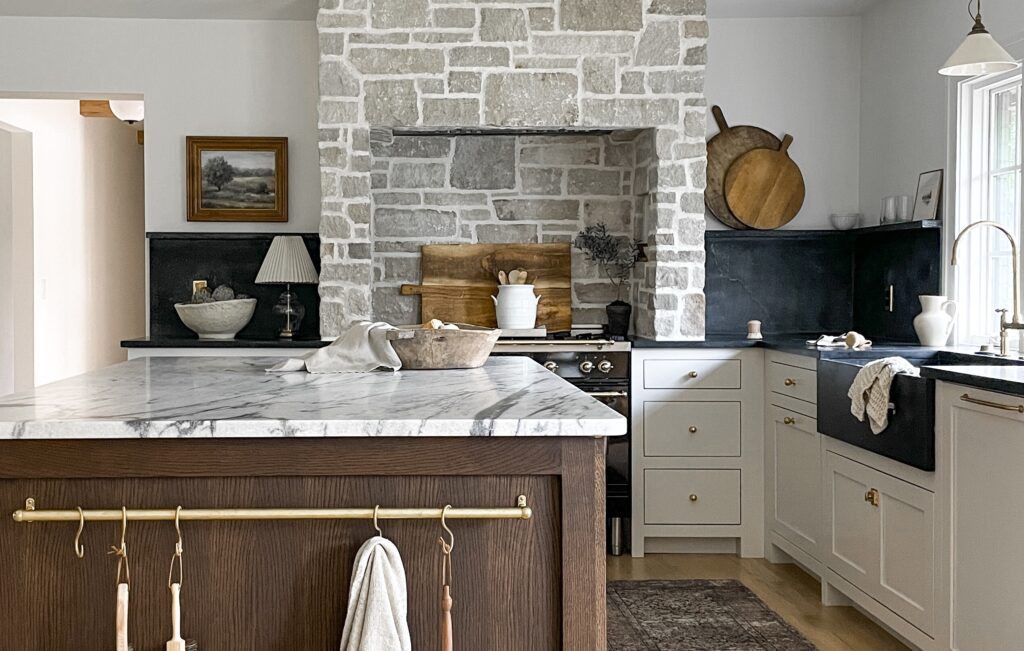
Proportional Relationships in Kitchen Design
Creating successful cabinet and countertop pairing tips requires understanding how proportional relationships affect visual perception and overall design success. The relationship between cabinet mass, countertop thickness, and overall kitchen scale significantly impacts the final aesthetic outcome.
Scale Considerations:
- Large kitchens can accommodate bold patterns and dramatic contrasts
- Small kitchens benefit from subtle patterns and light color combinations
- High ceilings allow for dramatic cabinet heights and substantial countertop edges
- Low ceilings require careful proportion management to avoid overwhelming the space
Visual Weight Balance:
- Dark cabinets require lighter countertops to maintain visual balance
- Light cabinets can support both light and dark countertop selections
- Busy cabinet details need simple countertop patterns for harmony
- Simple cabinet styles can accommodate dramatic countertop patterns
Lighting Considerations in Material Selection
How to choose countertop color often depends heavily on the kitchen’s natural and artificial lighting conditions. Materials that appear perfect in showroom lighting may look completely different in your specific kitchen environment, making it essential to evaluate samples under actual installation conditions.
Natural Light Considerations:
- North-facing kitchens benefit from warm countertop colors to counteract cool light
- South-facing kitchens can accommodate both warm and cool countertop selections
- East and west-facing kitchens experience changing light throughout the day
- Limited natural light requires careful consideration of reflective countertop surfaces
Artificial Lighting Impact:
- LED lighting provides consistent, cool light that affects color perception
- Halogen lighting creates warm light that enhances warm countertop tones
- Under-cabinet lighting dramatically affects countertop appearance and selection
- Pendant lighting creates focused illumination that highlights countertop patterns
Creating Flow in Open Floor Plans
Modern homes often feature open floor plans where kitchens flow seamlessly into adjacent living spaces, requiring harmonious kitchen design ideas that coordinate with broader interior design schemes while maintaining kitchen-specific functionality and aesthetics.
Open Plan Design Strategies:
- Consistent color temperatures throughout connected spaces create visual flow
- Repeated materials and finishes tie spaces together without exact matching
- Transitional elements help bridge different functional areas
- Strategic contrast points create definition without creating barriers
Material Coordination Across Spaces:
- Kitchen countertops should coordinate with adjacent room surfaces
- Cabinet colors should complement living area furniture and finishes
- Hardware finishes should repeat throughout connected spaces
- Flooring transitions should enhance rather than interrupt visual flow
Professional Design Tips and Common Mistakes

Insider Secrets from Design Professionals
Professional designers rely on specific strategies and techniques to ensure successful cabinet and countertop color combinations that satisfy both aesthetic and practical requirements. These insider approaches help avoid common pitfalls while maximizing design impact and client satisfaction.
Professional Selection Process:
- Always view samples in actual installation lighting before making final decisions
- Consider maintenance requirements alongside aesthetic preferences
- Plan for aging and patina development in natural materials
- Coordinate with appliance finishes for cohesive integration
- Consider resale value implications of bold or highly personalized choices
Design Development Strategies:
- Create sample boards with all materials together before ordering
- Consider seasonal lighting changes in material evaluation
- Plan for future updates and refresh possibilities
- Coordinate with architectural elements like flooring and trim
- Balance personal preferences with broad market appeal
Common Mistakes to Avoid
Understanding common mistakes in matching cabinets and countertops helps ensure successful outcomes while avoiding costly errors that can compromise both aesthetics and functionality. These mistakes often result from rushing the selection process or failing to consider long-term implications.
Frequent Selection Errors:
- Choosing materials based on small samples without seeing full slabs
- Ignoring undertone coordination between cabinets and countertops
- Selecting trendy combinations that may quickly become dated
- Failing to consider maintenance requirements of different materials
- Overlooking lighting impact on material appearance
Installation and Planning Mistakes:
- Inadequate edge detail consideration for countertop selections
- Poor proportion planning for cabinet and countertop relationships
- Insufficient lighting planning for dark cabinet installations
- Ignoring workflow considerations in material placement
- Failing to coordinate with backsplash and hardware selections
Budget-Conscious Strategies for Professional Results
Achieving professional-quality best cabinet and countertop combos doesn’t always require premium budgets when strategic planning and smart material selections are employed. Understanding where to invest and where to save allows for maximum impact within budget constraints.
Cost-Effective Approaches:
- Invest in quality cabinet boxes and upgrade doors and hardware later
- Choose consistent countertop patterns to minimize waste and seaming costs
- Select standard edge profiles to reduce fabrication costs
- Consider quartz alternatives that provide similar aesthetics at lower costs
- Plan installations carefully to minimize waste and additional charges
Strategic Investment Priorities:
- Cabinet hardware and soft-close mechanisms for daily functionality
- Quality countertop fabrication and installation for long-term durability
- Adequate lighting systems to showcase material selections properly
- Professional design consultation to avoid costly mistakes
- Quality installation to ensure proper function and appearance
Frequently Asked Questions
Should I choose light or dark countertops with white cabinets?
White cabinets with granite countertops work beautifully with both light and dark options, depending on your design goals. Light countertops create serene, spa-like atmospheres and make spaces feel larger, while dark countertops add drama and sophisticated contrast. Consider your kitchen's natural light, overall size, and desired aesthetic when making this choice. Light countertops are safer for resale value, while dark options create more distinctive, memorable spaces.
How do I avoid making my kitchen look dated?
Focus on neutral kitchen color palettes and classic combinations that have proven staying power. Avoid highly trendy colors or patterns that may quickly become dated. Instead, choose timeless combinations like white cabinets with natural stone countertops, or wood cabinets with neutral quartz. Add personality through easily changeable elements like hardware, lighting, and accessories rather than permanent installations.
What countertop materials work best with dark cabinets?
Dark cabinets with light countertops create sophisticated, high-contrast designs that work particularly well in larger kitchens with good lighting. Excellent options include white marble, light granite, cream-colored quartz, and light gray natural stone. These combinations require adequate lighting to prevent the space from feeling too dark or closed-in.
How important is it to match undertones exactly?
Matching cabinets and countertops doesn't require exact undertone matching, but they should be harmonious. You can successfully mix warm and cool undertones when done intentionally, but avoid accidental clashing by understanding the temperature of your materials. When in doubt, stick with materials that share similar undertones for foolproof coordination.
What's the difference between natural stone and quartz for design coordination?
Quartz countertops with modern cabinets offer consistent patterns and colors that make design coordination easier and more predictable. Natural stone provides unique character and variation but requires more careful selection to ensure slab-to-slab consistency. Quartz is ideal when you need precise color matching, while natural stone is perfect when you want organic variation and authentic character.
Conclusion
Mastering the art of matching cabinets and countertops requires understanding both the technical aspects of color coordination and the practical considerations of daily kitchen use. The most successful combinations balance aesthetic appeal with functional requirements while considering long-term satisfaction and resale value. Whether you’re working with white cabinets with granite countertops for timeless elegance or exploring dark cabinets with light countertops for dramatic sophistication, the key lies in understanding how materials interact and complement each other.
Professional-quality results come from careful planning, proper material evaluation, and attention to the details that create cohesive, sophisticated designs. Cabinet and countertop color combinations that stand the test of time focus on harmonious undertones, appropriate contrast levels, and materials that age gracefully together. The investment in proper planning and professional guidance pays dividends in both daily enjoyment and long-term value.
Kitchen color coordination guide principles provide the foundation, but successful implementation requires understanding your specific space, lighting conditions, and lifestyle needs. The most beautiful combinations mean nothing if they don’t function well for your daily routines or coordinate with your home’s overall aesthetic.
Ready to create the perfect cabinet and countertop combination for your next project? Contact RTG Cabinets for expert guidance and premium cabinet solutions that provide the perfect foundation for your countertop selections. Our experienced design team can help you navigate material options and create combinations that deliver both immediate impact and lasting satisfaction. Get a quote today to discover how professional cabinet selection can elevate your entire kitchen design.
Contact Information:
- Phone: +1 (888) 211-6482
- Email: info@rtgcabinets.com
- Website: RTG Cabinets
- Shop Now for immediate availability
Source Links
- National Kitchen & Bath Association – NKBA – https://nkba.org
- Interior Design Magazine – Interior Design – https://interiordesign.net
- Kitchen Cabinet Manufacturers Association – KCMA – https://kcma.org
- Natural Stone Institute – NSI – https://naturalstoneinstitute.org
- Quartz Surface Institute – QSI – https://quartzsurfaceinstitute.org






